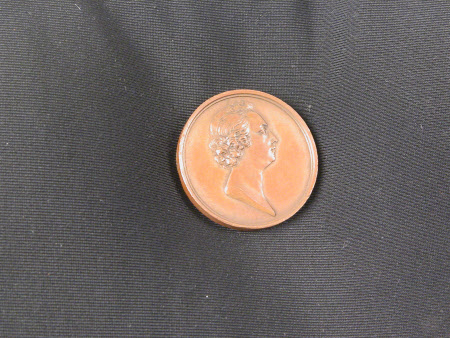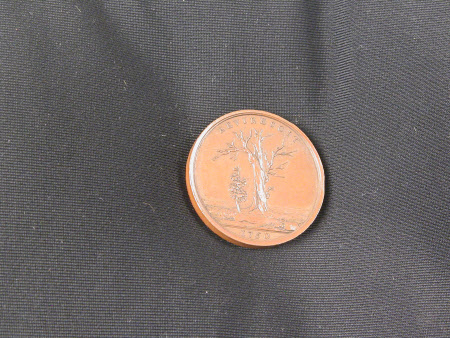The Oak Medal of Prince Charles, the Young Pretender
Thomas Pingo, the younger (1714-1776)
Category
Coins and medals
Date
1750
Materials
Copper
Measurements
34 mm (Diameter)
Place of origin
London
Order this imageCollection
Osterley Park and House, London
NT 773309
Summary
Copper, the Oak Medal of Prince Charles Edward Stuart, ‘The Young Pretender’ (1720-1788), by Thomas Pingo (1714-76), struck London, United Kingdom, 1750. A copper medal by Thomas Pingo known as the Oak Medal. The obverse depicts Prince Charles Edward Stuart, ‘The Young Pretender’ in profile facing right; the reverse has a blasted oak tree in a desolate landscape, next to which sprouts a sapling. The Latin legend translates as ‘It flourishes anew’ and the date 1750 is in the exergue. The medal was privately executed by Thomas Pingo in 1750, for members of a Jacobite Society which met at the Crown and Anchor inn, opposite to St. Clement's Church, in the Strand, London.
Full description
The portrait of the Young Pretender is copied from a medal recording the hoped for return to Britain in 1745 of Prince Charles Edward Stuart, but made after that event, in 1748 (NT 773305-773306). The image is based on a bust of Prince Charles by the French sculptor Jean-Baptiste Lemoyne (1704-78), a version of which is at Sizergh Castle (NT 998576). The so-called Oak Medal was made by Thomas Pingo for the members of a Jacobite society that met at the Crown and Anchor inn, by St. Clement's Church, in the Strand, London. On payment of a subscription of one guinea, each member received an example of the medal in copper whilst, for versions in gold or in silver, the value of the metal was charged in addition to the subscription. Six examples were struck in gold, 102 in silver, 283 in copper and a further 50 in tin. The medal was, like most Jacobite medals, issued as a form of propaganda and a means by which to keep the cause alive. Even following the disastrous outcome of the 1745-46 failed invasion, the last realistic attempt to restore the exiled Stuarts to the throne of the United Kingdom, the Jacobite cause retained many adherents, not least in London. The re-use of the portrait from the earlier medal, which Prince Charles had commissioned in 1748 as the negotiations were underway for the Treaty of Aix-la-Chapelle, must have been deliberate. The meaning of the allegorical reverse, with its young tree growing strongly amidst a desolate landscape dominated by a dead oak, is self-evident. Jeremy Warren 2019
Provenance
Given to the National Trust in 1993 by George Child Villiers, 9th Earl of Jersey (1910-1998).
Marks and inscriptions
Reverse, legend: REVIRESCIT Reverse, exergue: 1750
Makers and roles
Thomas Pingo, the younger (1714-1776), medallist
References
Hawkins 1858: Edward Hawkins, ‘Medal of the Pretender’, Notes and Queries, 22 May 1858, pp. 417-18., pp. 417-18. Cochran-Patrick 1884: Robert William Cochran-Patrick, Medals of Scotland from the earliest period to the present time, Edinburgh 1884, pp. 73-74, no. 60, Pl. XIV, Fig. 4. Hawkins, Franks and Grueber 1885: Edward Hawkins, Augustus W. Franks and Herbert A. Grueber (eds.), Medallic Illustrations of the History of Great Britain and Ireland to the death of George II, 2 vols., London 1885, pp. 655-56, no. 359. Farquhar 1923-4: Helen Farquhar, ‘Some Portrait Medals struck between 1745 and 1752’, British Numismatic Journal, (1923-24), pp. 171-233, pp. 186-90. Skeet 1930: Francis John Angus Skeet, Stuart Papers, Pictures, Relics, Medals and Books in the Collection of Miss Maria Widdrington, Leeds 1930, p. 75. Woolf 1988: Noel Woolf, The Medallic Record of the Jacobite Movement, London 1988, pp. 116-18, no. 62:1. Eimer 1998: Christopher Eimer, The Pingo Family. Medal Making in 18th-century Britain, London 1998, p. 45, no. 5. Eimer 2010: Christopher Eimer, British Commemorative Medals and their Values, London 2010, p. 100, no. 625, Pl. 70.

